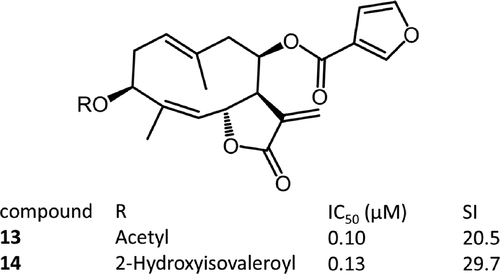当前位置:
X-MOL 学术
›
J. Nat. Prod.
›
论文详情
Our official English website, www.x-mol.net, welcomes your feedback! (Note: you will need to create a separate account there.)
Antiprotozoal Sesquiterpene Lactones and Other Constituents from Tarchonanthus camphoratus and Schkuhria pinnata
Journal of Natural Products ( IF 5.1 ) Pub Date : 2017-12-15 00:00:00 , DOI: 10.1021/acs.jnatprod.7b00747 Njogu M. Kimani 1 , Josphat C. Matasyoh 2 , Marcel Kaiser 3, 4 , Reto Brun 3, 4 , Thomas J. Schmidt 1
Journal of Natural Products ( IF 5.1 ) Pub Date : 2017-12-15 00:00:00 , DOI: 10.1021/acs.jnatprod.7b00747 Njogu M. Kimani 1 , Josphat C. Matasyoh 2 , Marcel Kaiser 3, 4 , Reto Brun 3, 4 , Thomas J. Schmidt 1
Affiliation

|
In continuation of a search for new antiprotozoal agents from plants of the family Asteraceae, Tarchonanthus camphoratus and Schkuhria pinnata have been investigated. By following the promising in vitro activity of the dichloromethane extracts from their aerial parts, bioassay-guided chromatographic isolation yielded two known sesquiterpene lactones (1 and 2) from T. camphoratus and 20 known compounds of this type from S. pinnata. From the latter, a new eudesmanolide, (1R*,5S*,6R*,7R*,8R*,10R*)-1-hydroxy-8-[5″-hydroxy-4′-(2″-hydroxyisovaleroyloxy)tigloyloxy]-3-oxoeudesma-11(13)-en-6,12-olide (3), and two new germacranolides, 3β-(2″-hydroxyisovaleroyloxy)-8β-(3-furoyloxy)costunolide (14) and 1(10)-epoxy-3β-hydroxy-8β-[5′-hydroxy-4′-(2″-hydroxyisovaleroyloxy)tigloyloxy]costunolide (16), were obtained. Additionally, the flavonoid pectolinarigenin (24) and 3-hydroxy-4,5-dimethoxybenzenepropanol (25) were also isolated from S. pinnata. The compounds were characterized by analysis of 1D and 2D NMR spectroscopic and HR/MS data. In vitro antitrypanosomal activity and cytotoxicity against mammalian cells (L6 cell line) were evaluated for all the compounds. Santhemoidin A (13) and 3β-(2″-hydroxyisovaleroyloxy)-8β-(3-furoyloxy)costunolide (14) were the most active compounds found in this study, with IC50 values of 0.10 and 0.13 μM against Trypanosoma brucei rhodesiense trypomastigotes and selectivity indices of 20.5 and 29.7, respectively.
中文翻译:

Tarchonanthus camphoratus和pinusata Schkuhria的抗原生动物倍半萜烯内酯和其他成分
在继续寻找从菊科,塔霍南楠(Tarchonanthus camphoratus)和羽扇(Schkuhria pinnata)的植物中寻找新的抗原生动物剂的研究。通过遵循从地上部分提取的二氯甲烷的有希望的体外活性,生物测定指导的色谱分离产生了来自樟脑樟脑的两种倍半萜烯内酯(1和2)以及来自南美假单胞菌的20种这种类型的已知化合物。从后者中得到一个新的马地雷内酯,(1 R *,5 S *,6 R *,7 R *,8 R *,10 R*)-1-羟基-8- [5″-羟基-4′-(2″-羟基异戊酰氧基)tigloyloxy] -3-氧代异戊烯11(13)-en-6,12-内酰胺(3)和两个新的杀菌剂,3β-(2″-羟基异戊酰氧基)-8β-(3-糠酰氧基)木香酚(14)和1(10)-环氧-3β-羟基-8β-[5′-羟基-4′-(2″-羟基异戊酰氧基)tigloyloxy]木香(16),获得。此外,类黄酮果胶素(24)和3-羟基-4,5-二甲氧基苯丙醇(25)也从S. pinnata中分离出来。通过分析1D和2D NMR光谱以及HR / MS数据对化合物进行表征。对于所有化合物,评估了其对哺乳动物细胞(L6细胞系)的体外抗锥虫活性和细胞毒性。Santhemoidin A(13)和3β-(2″-羟基异戊酰氧基)-8β-(3-糠酰氧基)木香内酯(14)是该研究中活性最高的化合物,对布氏锥虫锥虫的锥虫和选择性指数的IC 50值分别为0.10和0.13μM。分别为20.5和29.7。
更新日期:2017-12-15
中文翻译:

Tarchonanthus camphoratus和pinusata Schkuhria的抗原生动物倍半萜烯内酯和其他成分
在继续寻找从菊科,塔霍南楠(Tarchonanthus camphoratus)和羽扇(Schkuhria pinnata)的植物中寻找新的抗原生动物剂的研究。通过遵循从地上部分提取的二氯甲烷的有希望的体外活性,生物测定指导的色谱分离产生了来自樟脑樟脑的两种倍半萜烯内酯(1和2)以及来自南美假单胞菌的20种这种类型的已知化合物。从后者中得到一个新的马地雷内酯,(1 R *,5 S *,6 R *,7 R *,8 R *,10 R*)-1-羟基-8- [5″-羟基-4′-(2″-羟基异戊酰氧基)tigloyloxy] -3-氧代异戊烯11(13)-en-6,12-内酰胺(3)和两个新的杀菌剂,3β-(2″-羟基异戊酰氧基)-8β-(3-糠酰氧基)木香酚(14)和1(10)-环氧-3β-羟基-8β-[5′-羟基-4′-(2″-羟基异戊酰氧基)tigloyloxy]木香(16),获得。此外,类黄酮果胶素(24)和3-羟基-4,5-二甲氧基苯丙醇(25)也从S. pinnata中分离出来。通过分析1D和2D NMR光谱以及HR / MS数据对化合物进行表征。对于所有化合物,评估了其对哺乳动物细胞(L6细胞系)的体外抗锥虫活性和细胞毒性。Santhemoidin A(13)和3β-(2″-羟基异戊酰氧基)-8β-(3-糠酰氧基)木香内酯(14)是该研究中活性最高的化合物,对布氏锥虫锥虫的锥虫和选择性指数的IC 50值分别为0.10和0.13μM。分别为20.5和29.7。



























 京公网安备 11010802027423号
京公网安备 11010802027423号